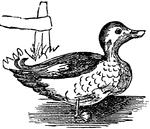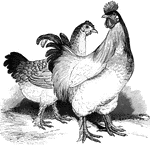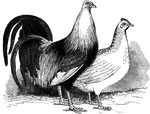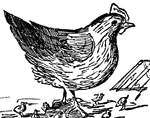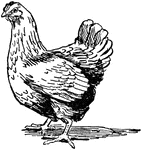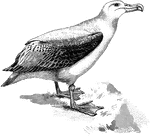
Wandering Albatros
"The Wandering Albatros of the Southern Oceans is white with narrow dusky undulations above and almost…
The Alimentary Canal of a Fowl
Birds usually have three cavities or stomachs. Labels: 1, The esophagus. 2, Ingluvies (crop). 2, Proventriculus…
The Alimentary Canal of the Flying Lizard
In reptiles the alimentary canal differs much from that of mammals or birds. As a general rule, it is…
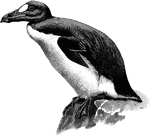
Great Auk
"This species (Alca impennis or Great Auk), extirpated chiefly by the persecution of fisherman, but…

Bell-Bird
"Chasmorhynchus niveus, the Bell-bird, ...have lores and orbits bare. The plumage is ordinarily plain…

Bill of Gadwall
The bill of the Gadwall Duck, showing the comb-like 'teeth' that they are known for.
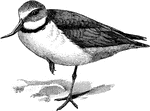
Wry-bill
Anarhynchus frontalis, the Wry-bill of New Zealand, is grey, with a black gorget and whitish lower parts;…
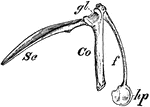
Bird Scapula
"Right shoulder-girdle or scapular arch of fowl, showing hp, the hypoclidium; f, furculum; Co, coracoid;…
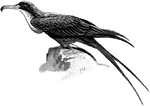
Frigate Bird
"The Frigate pr Mana-of-War-Bird... is met throughout the tropical regions, breeds in Laysan and has…

Secretary Bird
"Standing some four feet high on very long legs, this bird (Secretary Bird) gives the impression of…

Tropic Bird Sitting on a Ledge
The Tropic Bird " are chiefly found in the tropical regions of the south; ... this species breeds as…
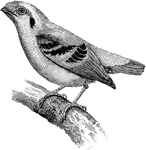
A Broadbill Sitting on a Tree Branch
"The plumage in the Calyptomena viridis of the Indo-Malay countries is bright green, with large black…
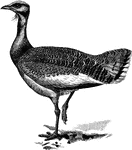
Great Bustard
"The Otis Tarda, the Great Bustard, which, as a native only became extinct in Norfolk about 1838, used…
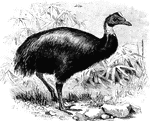
One-wattled Cassowary
One-wattled Cassowary "...Casuarius uniappendiculatus, of Salawatti and the adjoining parts of New Guinea,…
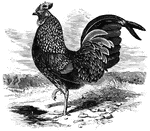
Kulm Rooster
Measuring twenty-six inches in height, the kulm cock is believed to have been brought from Java or Sumatra.
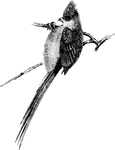
Cape Coly
"Colius capensis, or Cape Coly, has two stripes of black on the back enclosing one of white, the bare…
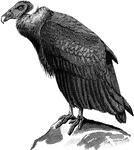
Condor
"On the Sarcorhamphus gryphus the Condor, the head and neck are bare, with dull red skin, wrinkled in…
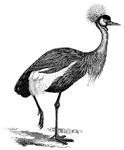
Crowned Crane
"Balearica pavonina, the "Crowned" Crane of the Northern Ethiopian Region, is greenish-black above and…

Two Radiated Ground Cuckoo, One with an Insect in its Mouth, the Other in a Tree Branch in a wooded Area
"The plumage is brownish, with white margins to the feathers and a purple tinge on the rufous-mottled…
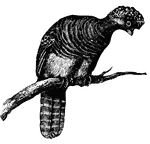
Curassow
Naturally very gentle, they readily yield to captivity, when they become familiar, and evince pleasure…
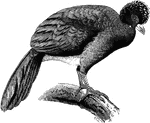
Crested Curassow
Crax alector, Crested Curassow, is black with a purplish gloss, the belly being white, the naked lores…
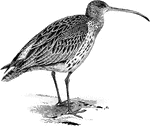
Curlew
"Numenius arquata, the Curlew or Whaup, breeds freely on the moorlands of Britain; and extends throughout…

Curlew Skull
"Schizorhinal skull of curlew (top view), showing the long cleft, a, between upper and lower forks of…
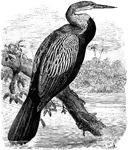
Indian Darter
"The Indian Darter (Plotus melangaster) or snake-bird of tropical and subtropical America, ranging northwards…

Great Northern Diver
The Great Northern Diver, Colymbus glacialis, "...is black above, with belts of white spots making a…
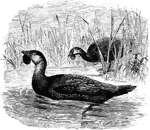
Two Musk Ducks Swimming between the Tall Grass in a Lake
Biziura lobata, (Musk Duck) of Tasmania and Australia -except the north-is brown with buff mottlings,…
Egyptian Chain
"A gold chain is formed of wires closely plaited and very flexible, the ends terminating in the heads…
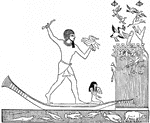
Egyptian Noble Hunting Waterfowl
"Egyptian noble hunting waterfowl on the Nile with the "throwstick' (a boomerang). The birds rise from…
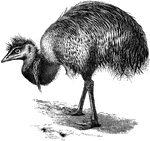
Emeu
An Emeu "Dromaeus novae-hollandiae, of the interior Eastern Australia, which extended in times past…

Paradise Flycatcher
"Terpsiphone paradisi, Paradise Flycatchers, have fine crests, shorter in the female; while fleshy wattles,…
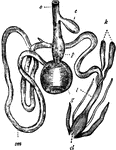
Fowl Digestive System
"Digestive system of the common Fowl. o, Gullet; c, Crop; p, Proventriculus; g, Gizzard; sm, Small intestine;…

Fowl Skull
The skull of an adult fowl. Here the temporal fossa is bridged over by the junction of the post-frontal…

Skull of a Common Fowl
"Fig. 62 Skull of common fowl, enlarged. from nature by Dr. R.W. Shufeldt, U.S.A. The names of bones…
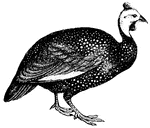
Guinea Fowl
Guinea fowls have small heads for their size; beak and neck short; the tail equally short and drooping.
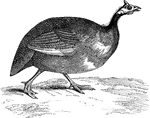
Guinea Fowl
The Guinea-fowl (or pintado) was originally native to Africa, but was introduced to American poultry-yards.
Kinds of Fowl
Kinds of fowl. Far left: light Brahma, behind Brahma: bantam, middle: long-tailed oriental fowl, right:…
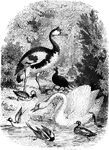
Group of Water Fowl
A group of water-fowl at a bank, with a fountain and pond visible in the background.

Gadwall Duck
The Gadwall (Chaulelasmus streperus) is a widely distributed duck, appearing throughout Europe and N.…

Gannet
"The Gannet (S. bassana) has slate-grey wing-quills, purplish-grey bill, reddish feet and naked parts."…
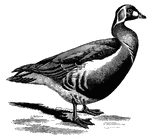
Red-breasted Goose
Bernicla ruficollis, the Red-breasted Goose of West Siberia, which migrates southwards, strays to Britain…

Little Grebe
"Both sexes of the Little Grebe are mainly dusky brown or blacking grey above, and silvery white below,…

Pallas's Sand Grouse
"Syrrhaptes paradoxus, Sand-Ground, are true desert birds, affording excellent instances of protective…
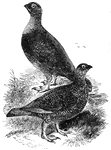
Red Grouse
Native only to the British Isles and the Orkneys, the red grouse is often bred in confinement to be…
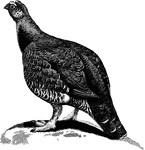
Red Grouse
"Lagopus scoticus, the Red Grouse or Muirfowl, the only bird entirely confined to our islands, differs…
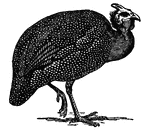
Guinea Fowl
Guinea Fowl are the African representatives of the pheasants, from which they differ in that the plumage…
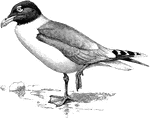
Great Black-Headed Gull
"Larus ichthyaetus, the Great Black-headed Gull, ranging from the Black Sea and the Levant to Tibet,…
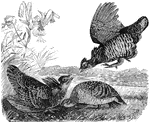
Prairie Hens
Prairie hens feed on grasshoppers, wheat, corn, seeds, and the buds of trees. They are also known as…



